
Rediscovering Japan

Rediscovering Japan
Travel (Tokyo (Hama-rikyu Gardens))

by tomizuta
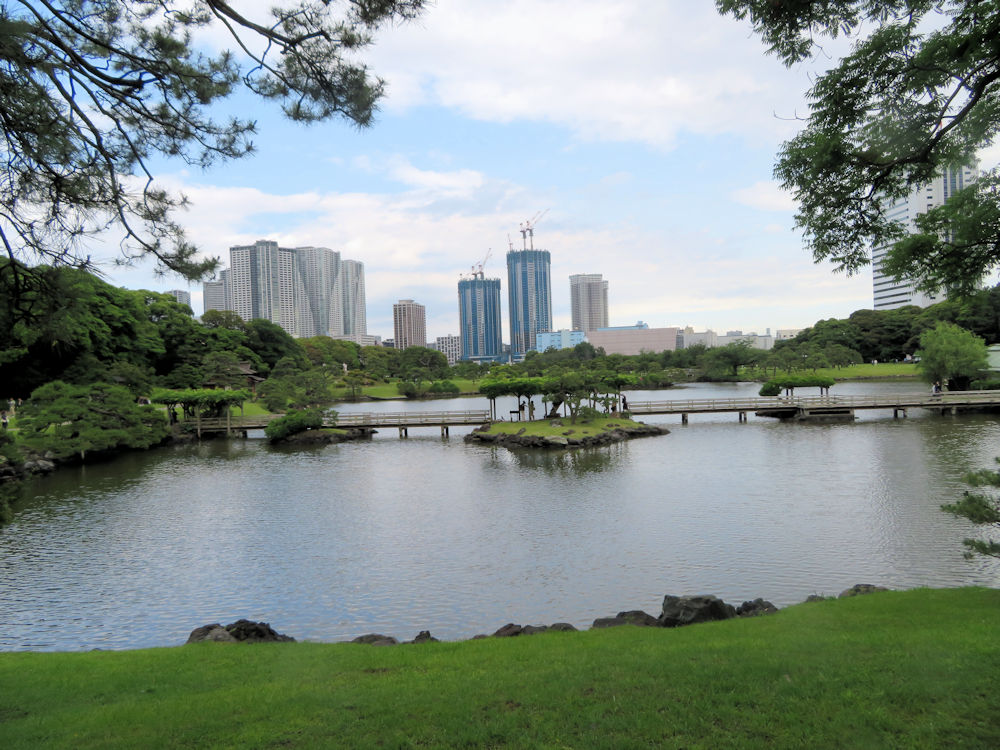
Hama-rikyu Gardens originally served as a falconry ground for the Tokugawa shogunate. A residence was constructed there in the mid-17th century, and the landscaping work continued over the years until the early 19th century, when the garden took on its present form.
There are nine gardens in Japan that have received dual designations as both a Special Historic Site and Special Place of Scenic Beauty. These classifications are based on Article 109 of the Act on the Protection of Cultural Properties, which states: “The Minister of Education, Culture, Sports, Science and Technology may designate particularly significant monuments as Historic Sites, Places of Scenic Beauty, or Natural Monuments.” It further stipulates that “among them, those of exceptional value may be designated as Special Historic Sites, Special Places of Scenic Beauty, or Special Natural Monuments.” Since designation as a National Treasure is limited to tangible Important Cultural Properties, these Special designations can be seen as the equivalent of “national treasure status” for historic sites and scenic locations. In the Kanto region, only two gardens have received this rare dual designation: Koishikawa Korakuen and Hama-rikyu Gardens. I visited Hama-rikyu Gardens for the first time at the end of May 2025. The garden lies southeast of JR Shimbashi Station. If you take the route through the underground concourse to the vicinity of Shiodome Station on the Oedo Line and then surface, it takes over 15 minutes on foot. Even Japanese visitors often find the route confusing, so for inbound tourists, taking a taxi is highly recommended.
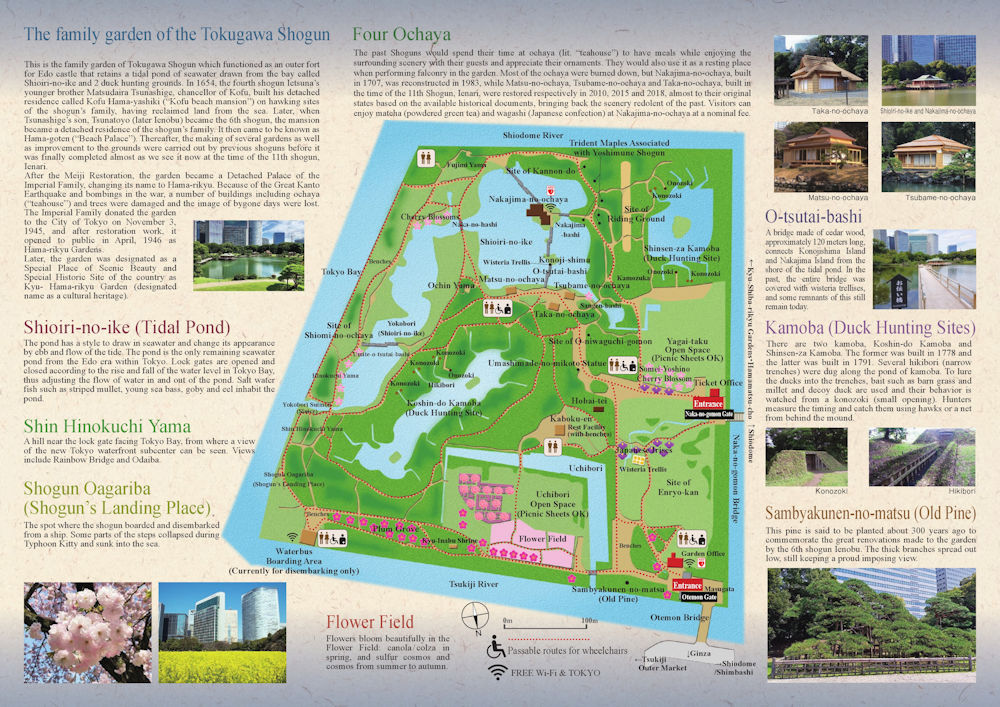
Map of Hama-rikyu Gardens available on Tokyo Metropolitan Park Association's website. I entered the garden from the Naka-no-gomon Gate shown on the center right.
Hama-rikyu Gardens originally served as a falconry ground for the Tokugawa
shogunate. A residence was constructed there in the mid-17th century, and
the landscaping work continued over the years until the early 19th century,
when the garden took on its present form. Following the Meiji Restoration,
the property became an imperial detached villa, or rikyu, which is how
it came to be called Hama-rikyu. Today, it is open to the public as a metropolitan
park managed by the Tokyo Metropolitan Government. Covering an area of
250,000 square meters, it is a vast garden. During the Edo period, it also
served a strategic role as an outer fortification of Edo Castle, guarding
against attacks from the sea. As a result, the garden’s southeastern edge
originally faced the open sea—though due to later land reclamation, it
now borders the Sumida River. Entrances to the garden are located at two
gates on the northeast side. We entered through the southern one, known
as the Naka-no-gomon (Central Gate).
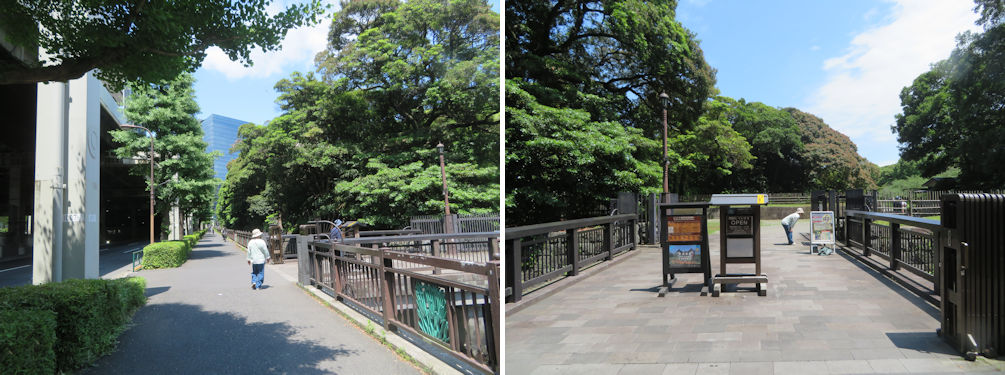
Coming from Toei Subway Oedo Line Shiodome, it was about a 10 minutes' walk to the The Naka-no-gomon Gate. Looking north as you approach the Naka-no-gomon Gate on the right (left), and view of the Naka-no-gomon entrance (right). The admission fee is 300 yen.
At Tokyo’s metropolitan gardens of note, guided tours led by volunteer guides are offered on weekends, except during the peak summer months of July and August. Japanese-language tours are held at 11:00 a.m. and 2:00 p.m. on Saturdays, Sundays, and national holidays, and an English-language tour is available at 11:00 a.m. I had planned to join a tour on the day of my visit, but since there was still some time before the meeting hour, I decided to take a quick walk around the garden first. As the meeting point was at the Otemon Gate, located north of the Naka-no-gomon Gate where I had entered, I chose to walk counterclockwise through the garden to reach it. Proceeding straight from the Naka-no-gomon Gate, I soon noticed a bed of irises blooming along the stream on my right—a lovely seasonal sight to begin the stroll.
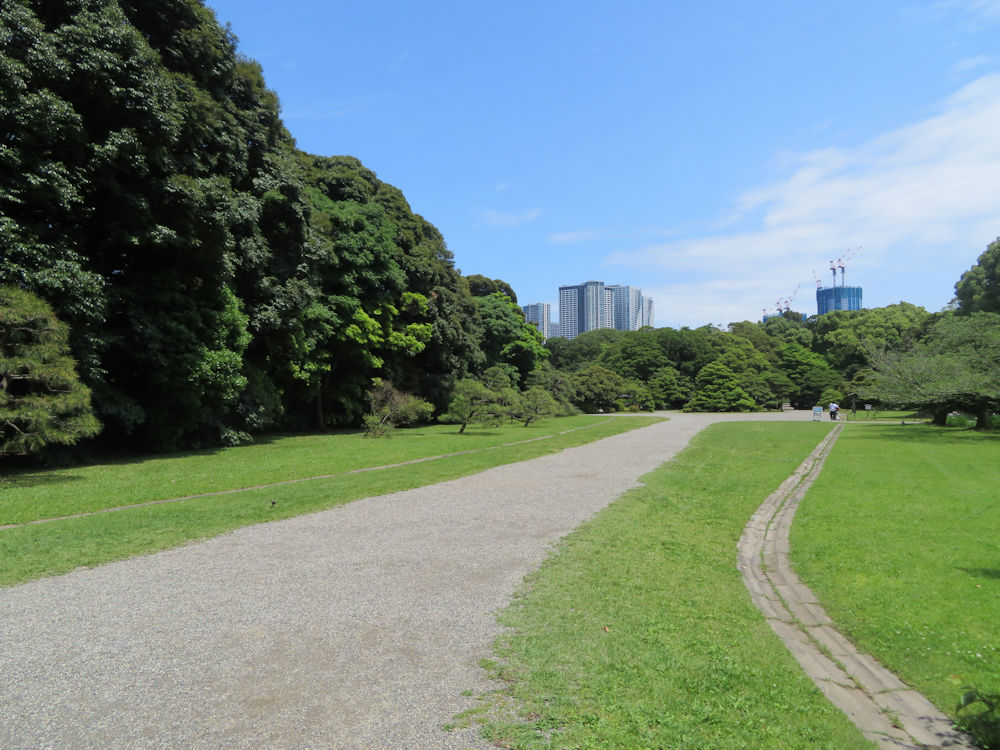
Upon entering through the Naka-no-gomon Gate, I was immediately struck by the vastness of the garden. Although not visible in the photo, the irises line the stream on the right.
Turning right at the end of the path, I soon found myself in a dense woodland area. Emerging from the woods, I was suddenly greeted by a large pond spanned by a prominent wooden bridge (O-tsutai-bashi) at its center. This is the Shioiri-no-ike, a tidal pond fed with seawater. One of the garden’s distinctive features is how the appearance of the pond changes with the ebb and flow of the tide. In fact, Hama-rikyu is said to be the only garden in Tokyo that still draws in seawater today.
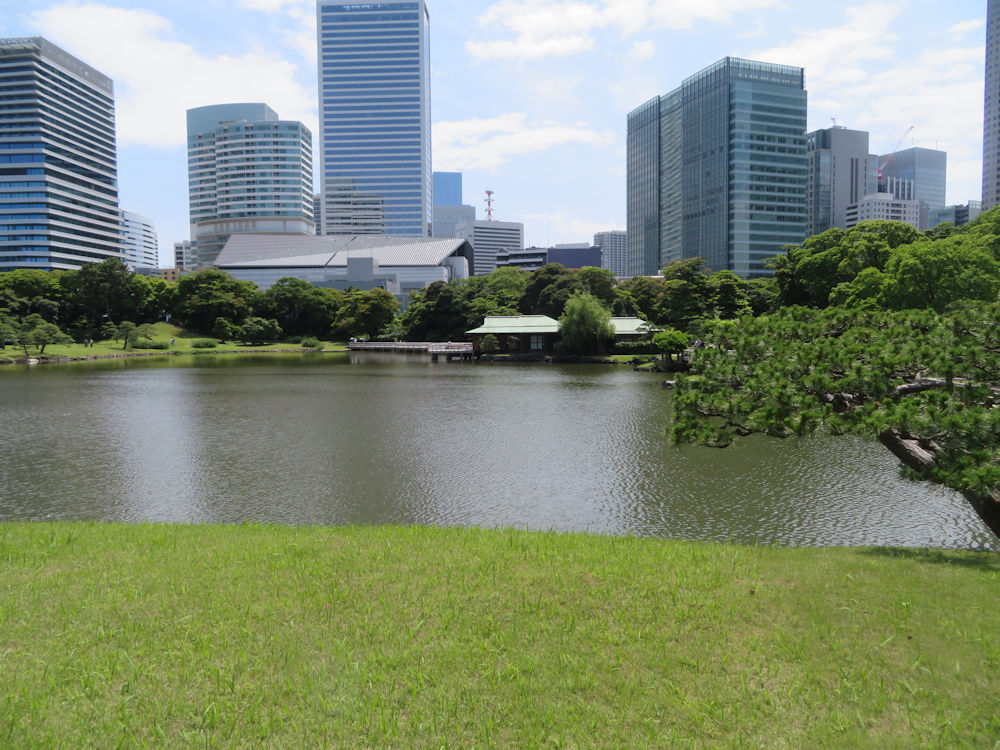
View of the Shioiri-no-ike from the northern bank. In the middle is Nakajima-no-ochaya, a teahouse on an island in the middle of the pond originally built in 1707 that was reconstructed in 1983. You can see the southern side of the wooden bridge stemming from the left side of the tea house.
The Otsutai-bashi is a 120-meter-long bridge made entirely of Japanese cypress. Part of the bridge was covered with wisteria. In the past, the entire length of the bridge was covered by wisteria trellis.
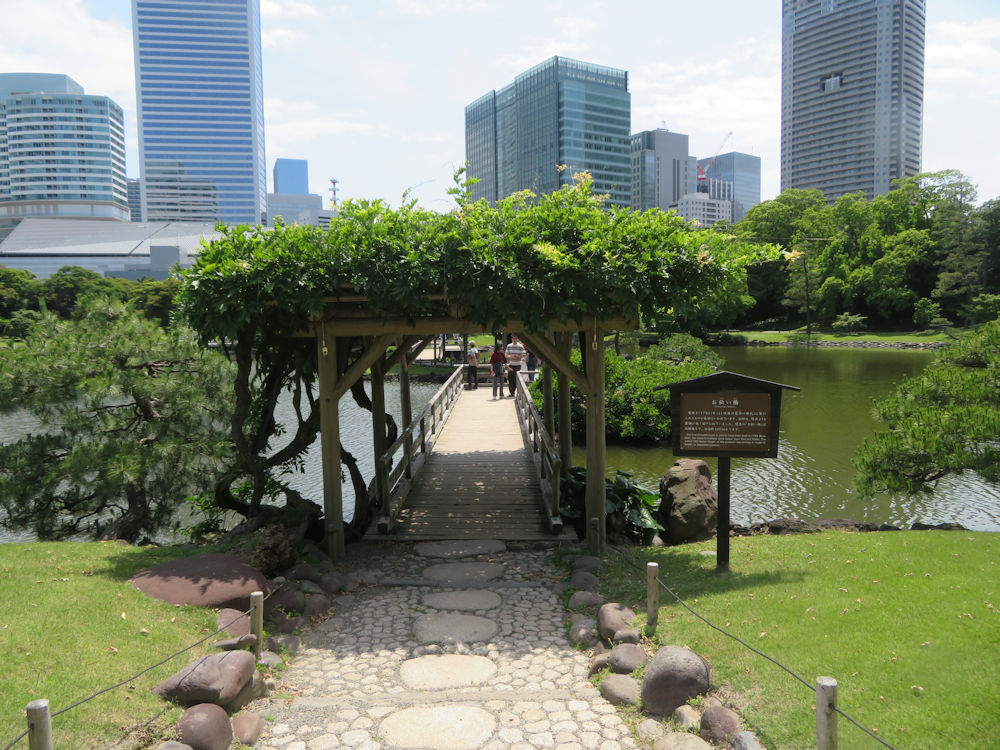
Start of the wooden bridge from the northern side. Notice the wisteria trellis. It was already past the flowering season (May).
Near the edge of the pond stands a small artificial hill called Ochinyama. I decided to climb it. Even after looking into its history, I couldn’t find any information about the origin of its name. It appears to be a man-made hill (tsukiyama) created to offer scenic views—and it’s certainly worth the short climb.
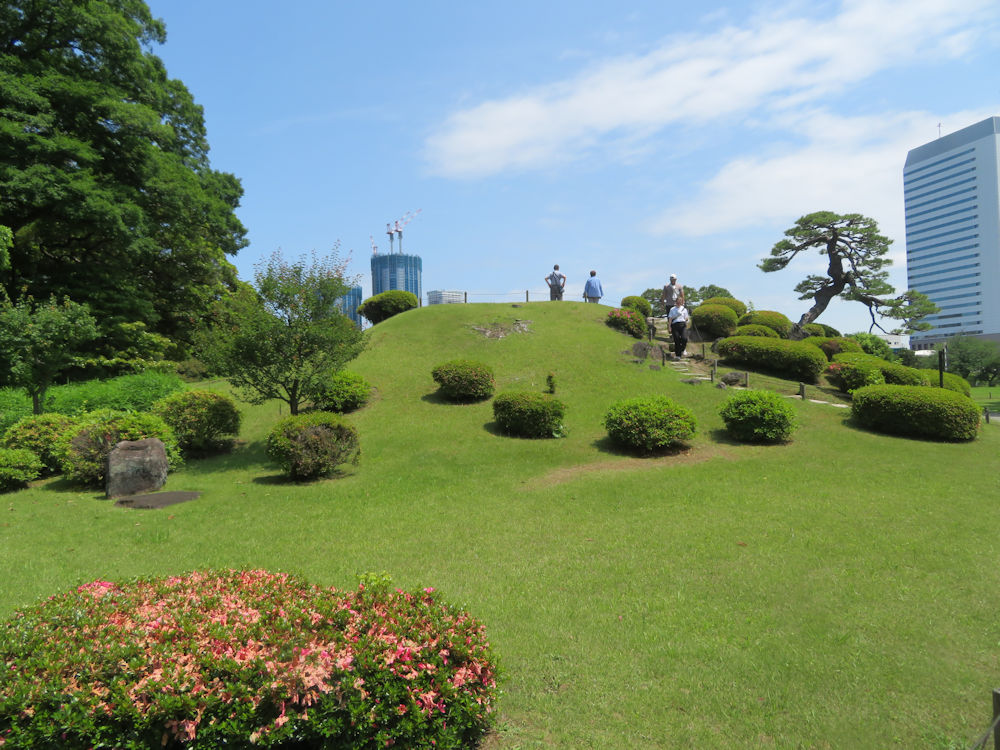
Near the edge of the pond stands a small artificial hill called Ochinyama.
As I walked from Ochinyama toward the Otemon Gate, I came across a small hut-like structure on my left. Approaching it and reading the explanation, I learned that it was a type of hunting blind called a konozoki, where hunters would hide to observe the ducks without being seen. Behind the konozoki lies a large pond, and extending from the pond toward the blind is a trench designed to lure the ducks in. When a wooden board inside the blind was struck, the sound signaled the trained decoy ducks, which had learned to associate it with feeding, to enter the trench. Wild ducks, drawn in by the movement of the decoys, would follow—at which point they were captured using hawks or nets. Given that this garden once served as a falconry ground for the Tokugawa shogunate, such a facility is only natural, yet I still found it striking in its ingenuity. Two such duck hunting sites (kamoba) remain preserved in Hama-rikyu Gardens today, making them valuable cultural heritage assets. They are believed to have been constructed in the late 18th century, during the latter half of the Edo period. This timing aligns with the broader history of falconry in Japan: while it flourished during the early Edo period, it was temporarily discontinued in the late 17th century due to the Shorui Awaremi no Rei (Edicts on Compassion for Living Creatures) issued by the fifth shogun, Tsunayoshi. It was later revived in the 18th century by the eighth shogun, Yoshimune.
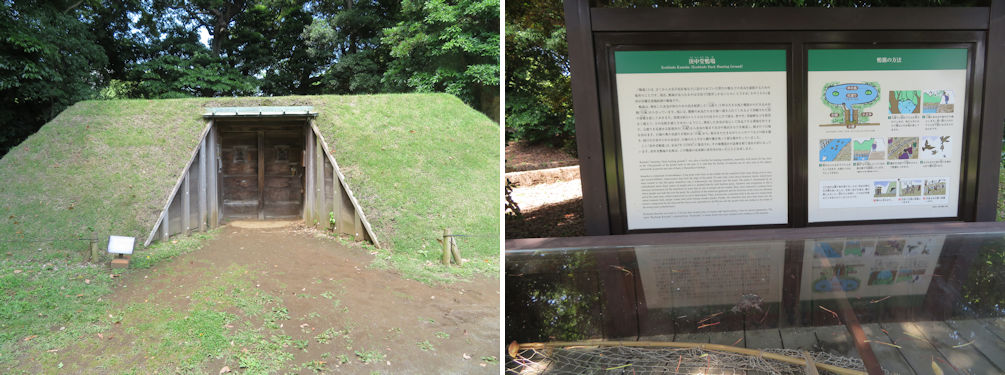
A konozoki (literally small peephole), which is a structure for people to hide and scatter food to lure the birds toward the trench built behind. Behind the konozoki is a pond to attract the fowl (left). There is a detailed description beside the konozoki that tells how they caught the fowl (right).
Continuing further toward the waterfront, I passed a sluice gate that brings seawater into the garden and arrived at the edge of the Sumida River, which flows into Tokyo Bay. Here, along the stone embankment, remains can be seen of the Shogun Oagariba, a landing site once used exclusively by the shogun when arriving at the garden by boat. In Edo, a network of moats and waterways crisscrossed the city, and it seems that even the shogun frequently traveled by boat. Just beyond this site is a pier used by the Tokyo Metropolitan Government’s water buses. While boats currently arrive here from Asakusa and Ryogoku, boarding is not permitted—only disembarkation is allowed at this stop.
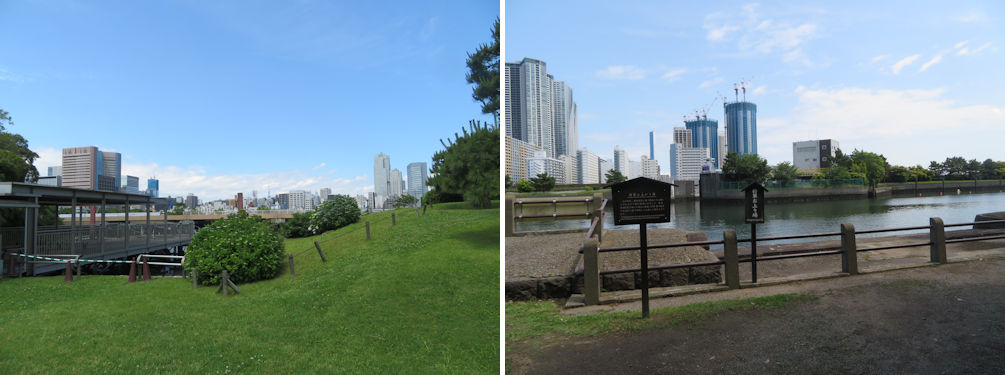
(right) Site of the Shogun Oagariba. The river behind is Sumida River. Before the land reclamation in modern times, this would have been the seafront of Tokyo Bay. (left) The Water Bus pier. You can barely make out Tokyo Skytree in the background. The water bus cruises Sumida River downstream from that area (Asakusa) to reach this pier.
From this point, it’s a straight ten-minute walk along the Tsukiji River, which flows into the Sumida River, to reach the Otemon Gate. Along the way, I came across a small shrine that appeared to have historical significance. According to the sign, it was the Kyu-Inabu Shrine. The original shrine collapsed in the major earthquake of 1894, and several small shrines that had existed within the garden were consolidated and rebuilt here under that name. Although it later suffered damage in events such as the Great Kanto Earthquake, it was reconstructed in 2007 to reflect its original Meiji-period appearance. Historical maps of the garden from the Edo period are said to include a record of an Inari Shrine on the site. The presence of Inari shrines in many daimyo gardens may suggest the feudal lords' sincere wishes for a good harvest in their rural feudal domains.
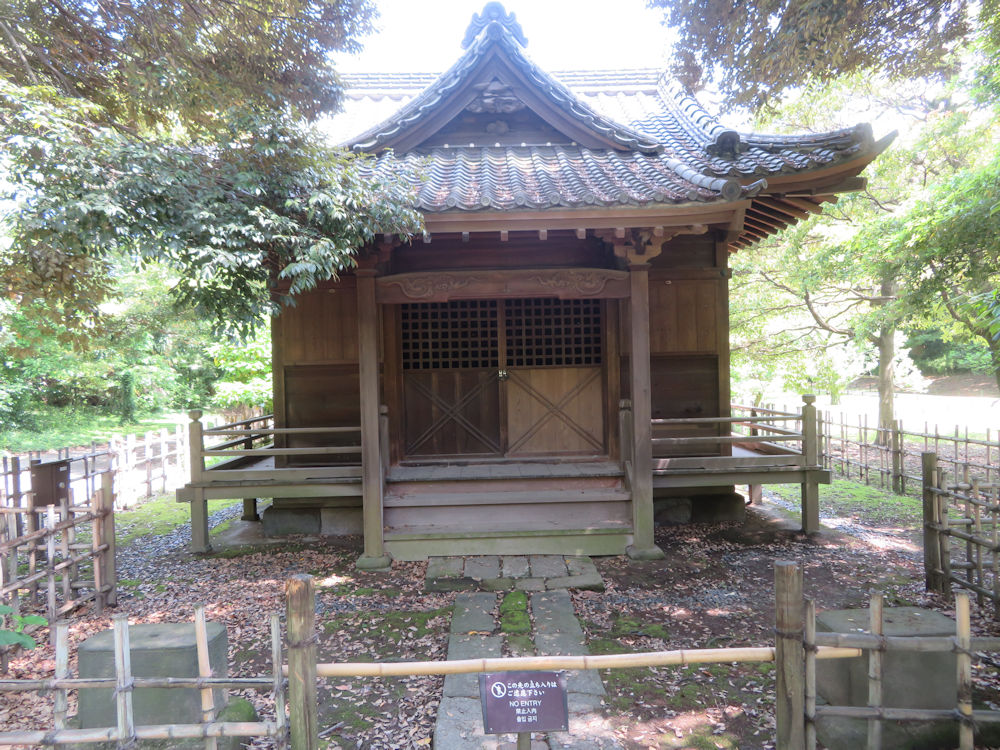
The Kyu-Inabu Shrine. It was reconstructed in 2007 to reflect its original Meiji-period appearance.
The meeting point for the volunteer-guided tour was near the Otemon Gate. Otemon refers to the main gate of a castle. That’s why place names like Ote, Otemon, and Otemachi remain in various parts of Japan—Otemachi in Tokyo being a prime example—and these places are typically located in the central areas of cities. Seeing the Otemon Gate here, I was reminded once again that this too had once been part of a castle complex. It gave me a clear sense of the site’s historical role.
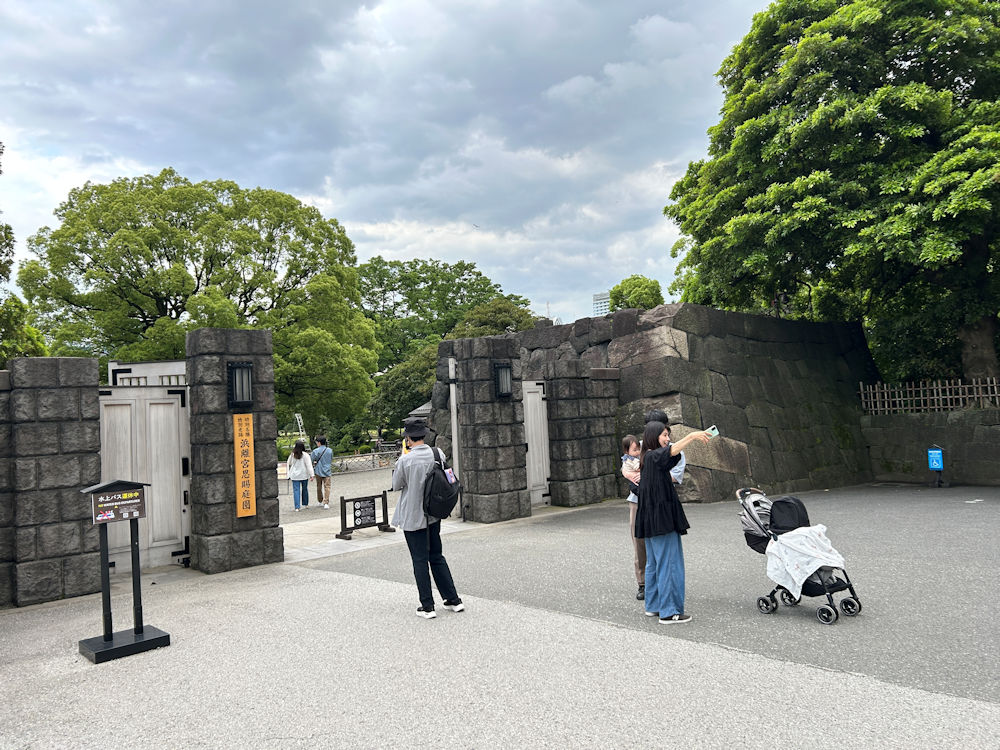
The Otemon Gate. Seeing the Otemon Gate here, I was reminded once again that this too had once been part of a castle complex.
There were two volunteer guides, and we joined the group led by the older of the two. Volunteer guides at Tokyo’s metropolitan parks receive official training from the Tokyo Metropolitan Government and are provided with shared materials about the parks they serve, which helps ensure a certain level of consistency and quality in the tours. That said, it’s not realistic to expect guides to know everything. I was once asked—while guiding foreign visitors myself—how to tell whether a guide is good. I replied immediately, “Be cautious of guides who pretend to know everything. No one can possibly know it all. A guide who says ‘I’m not sure, so let me look that up,’ and checks online, is much better than one who just gives an offhand answer.” Of course, each guide has their own areas of interest, and that passion often comes through. In our case, the guide seemed especially fond of botany—his explanations of the plants were unusually detailed. The first stop on our tour was a large pine tree near the Otemon Gate. This black pine, estimated to be around 300 years old, is said to have been planted to commemorate the major redevelopment of this area by Ienobu Tokugawa, the sixth shogun of the Tokugawa shogunate. His father, Tsunashige Matsudaira, had reclaimed this land from the sea to build a secondary residence for the Kofu branch of the Tokugawa clan. Incidentally, the main residence (kamiyashiki) of the Kofu Domain at the time stood on the site where Hibiya Park is located today.
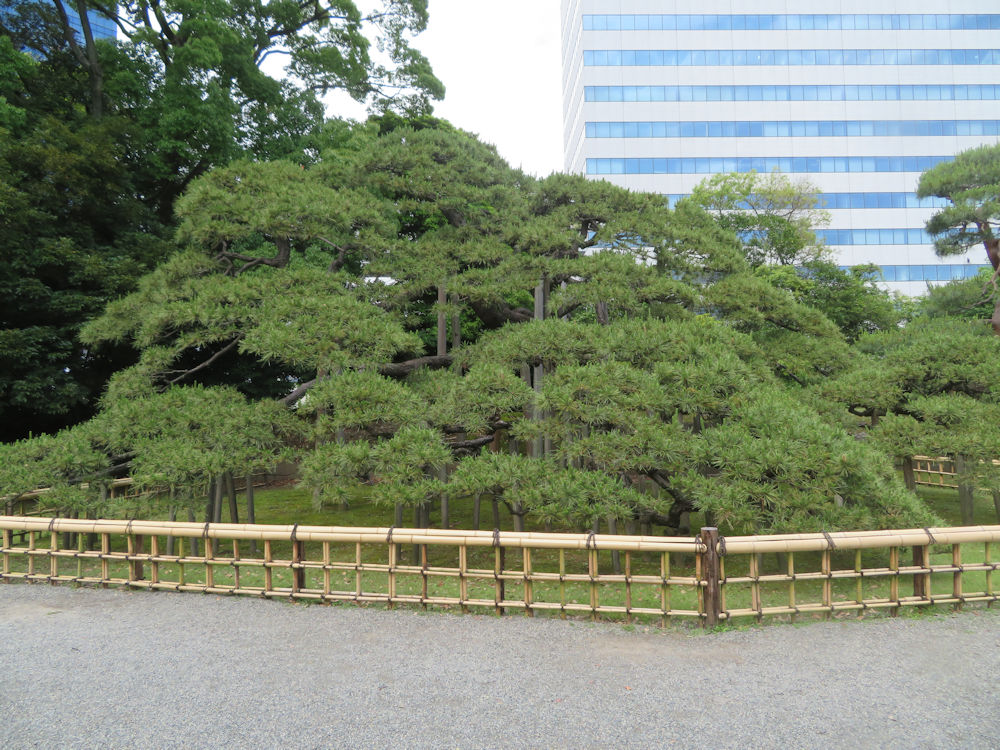
The magnificent 300 year old black pine.
From there, we headed back in the direction of the Naka-no-gomon Gate, where we had first entered the garden. We followed the same route we had taken earlier on our own and emerged once again in front of the tidal pond. Along the way, the guide gave various explanations about the plant life, but I will omit those details here. The guide then led our group to the southwestern edge of the garden (which appears in the upper right corner of the map above). The first site introduced in this area was the well-preserved remains of a horseback riding ground (baba-ato).
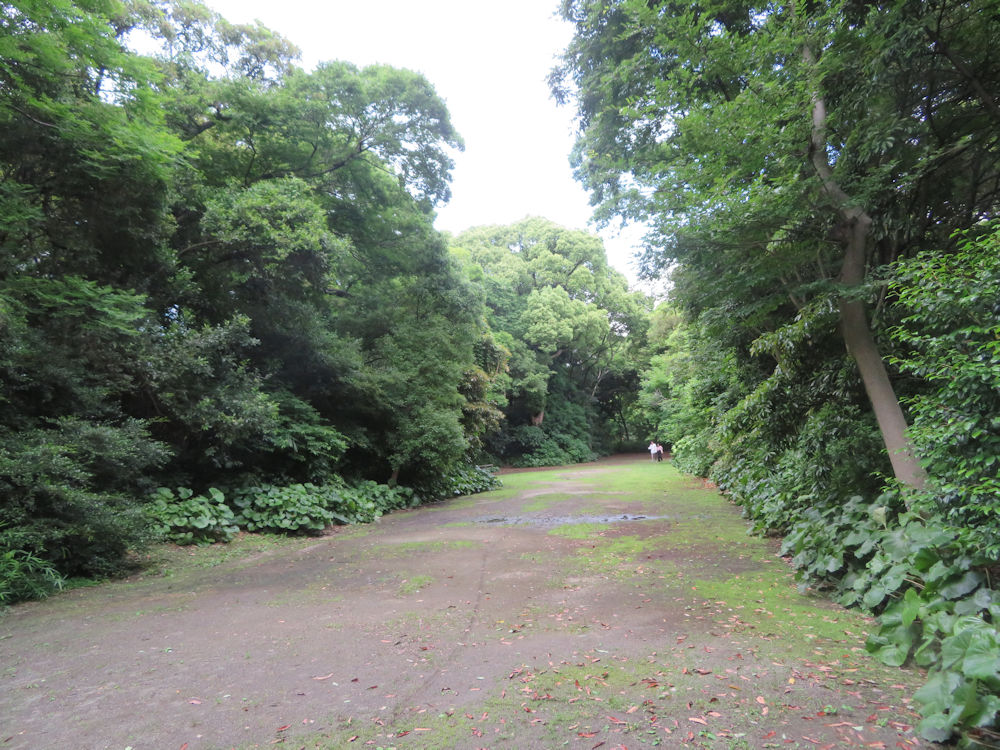
Site of the former riding ground.
Next, we visited another kamoba—a duck hunting site different from the one we had seen earlier. This one was constructed about ten years later, also in the late 18th century, as part of the garden’s hunting facilities. Here, a structure known as an oonozoki, or large observation blind, which was used to observe the ducks on the pond below, still remains atop a small hill.
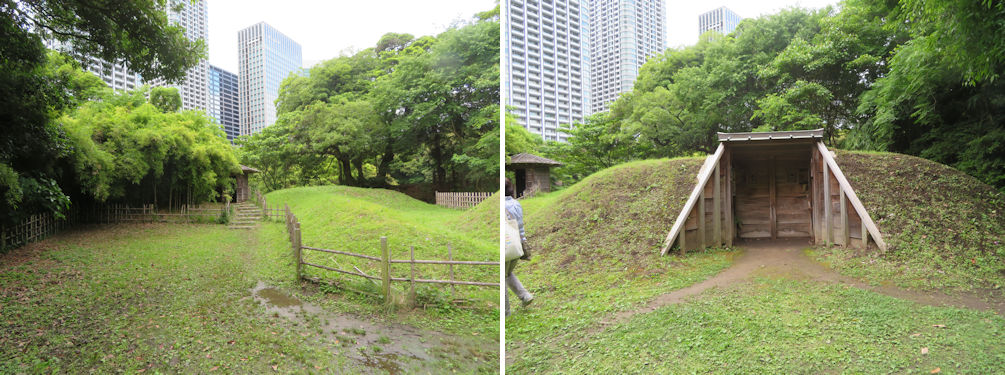
(left) The oonozoki atop a small hill. The pond is on the other side of the hill. (right) The konozoki of the second kamoba.
Before long, the guided tour came to an end. While my original intention in visiting had been to study a representative example of a traditional Japanese garden, I came away with the strong impression that this site is distinguished more by its character as a Special Historic Site—with features such as the duck hunting grounds, the riding ground, and its former role as a strategic outpost for Edo Castle. At the same time, if we consider a garden to be a place where one enjoys a semi-natural, man-made landscape, then this is clearly a different type of garden—distinct from those designed for strolling around a pond to appreciate seasonal scenery and flowers. It stands apart as a unique example in its own category.
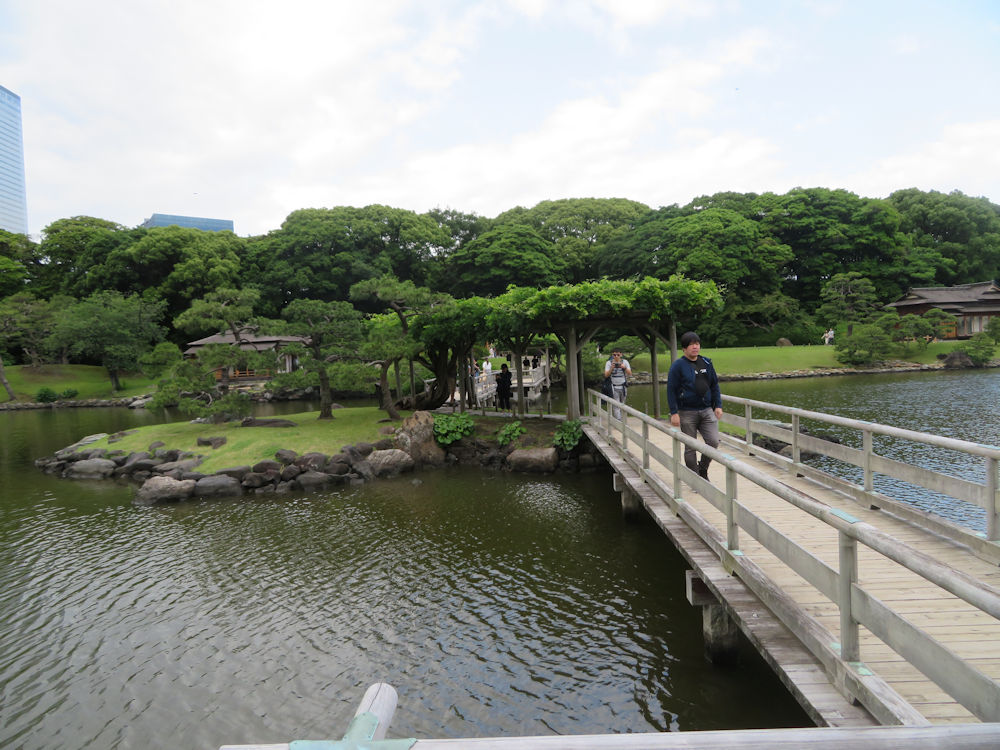
From the second duck hunting site, we returned by crossing the Otsutai-bashi Bridge from the opposite side of where we had first viewed it.